- Published 17 Feb 2023
- Last Modified 29 Aug 2023
- 10 min
Drill Bit Sets - A Complete Guide
Our guide will help you understand what drill bit sets are as well as the types of sets and drill bits available.

Reviewed by David Carmichael, Solution Engineer (January 2022)
What are Drill Bit Sets?
Drill bit sets include a collection of drill bits, typically featuring a range of sizes to ensure suitability for different applications. Drill bits are the tools which allow drills to cut holes into different materials through the application of circular torque, or rotational force. The upper part of a drill bit is called the shank and this is attached to the chuck, a special clamp within the main body of the drill.
Most modern drill bits are made from various types of steel. Some of the most common types include:
- Carbon Steel – this is the ideal choice if you need a tough drill bit able to cut into harder substances. Carbon steel is resistant to high temperatures and bits made from this material typically have longer lifespans than alternative options
- High-Speed Steel (HSS) – this material remains firm when subjected to high temperatures and can cut quickly and accurately
- Cobalt Steel – the cobalt admixture increases strength and resistance to both heat and friction
- Tool Steel with Tungsten Carbide Tips (TCT) - these have a tough and stable tip with a longer working life
In addition to the use of alloys, modern drill bits often include chemical coatings to enhance their performance. Common coatings include:
- Black Oxide – this prevents corrosion and increases resistance to stress. It also helps to retain any lubricants which have been applied, making it a good choice for iron and steel drilling
- Bronze Oxide – this coating is also an effective choice for additional stress resistance. It is often used to help identify cobalt steel and can be used in combination with black oxide to help identify high-speed steel bits
- Titanium Nitrate – added to increase the rigour of drill bits, this coating also helps to protect against the high temperatures generated by frictive materials like iron, steel and aluminium, thereby increasing their lifespan
- Ferrous Oxide - another coating which provides effective shielding against heat
Drill bit sets are useful because they contain a selection of drill bits in different shapes and sizes. Some contain bits specifically designed for use with certain substances - for example, masonry, wood, metal, plastic, concrete etc - while others are intended to meet the needs of professionals who routinely work with multiple materials.
Drill bit sets made specifically for hobbyists and DIY enthusiasts are also available. These tend to feature smaller bits intended for lighter work. Drill bit sets are normally supplied in sturdy carry cases, with individual components on clear display for ease of use.
Types of Drill Bit Sets
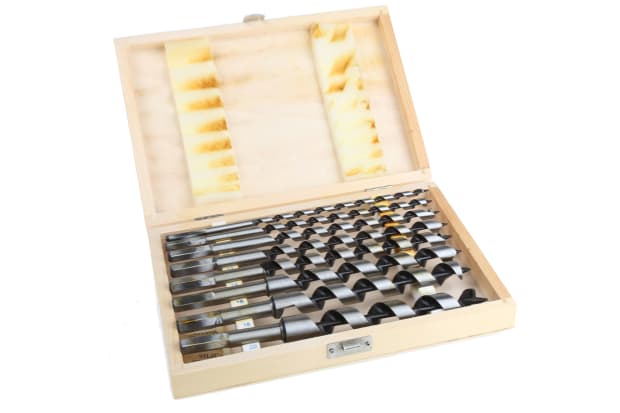
Auger Drill Bits
Auger drill bits are very distinctive-looking bits featuring sharp helical spirals along their shaft called ‘flightlings’. They are designed to produce smooth, uniform holes, typically in wood, while also removing the shavings. Auger drill bits can also be used for cutting through ice. Dirt or ground auger drill bits perform the same function for cutting through soil. Auger drill bit sets will offer a good selection for use on handheld power drills.
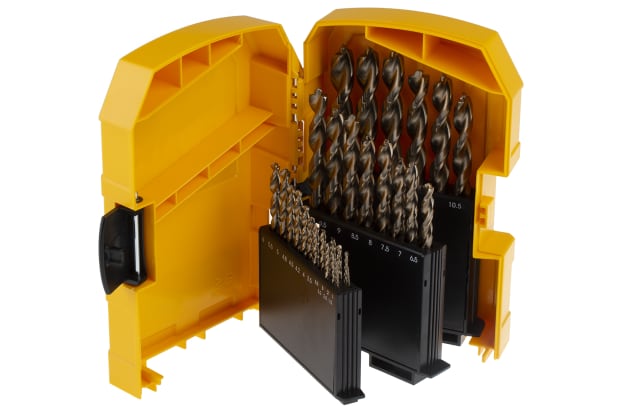
Cobalt Drill Bits
Cobalt drill bit sets are high-performance tools. The bits are actually made primarily from steel but a 5% cobalt admixture provides additional strength and heat resistance, even if cooling is limited. Cobalt drill bits can be used with resistant, high tensile metals - those which retain strength under tension. They include stainless steel, carbon steel, cast iron, titanium alloys and carbon fibre composites.
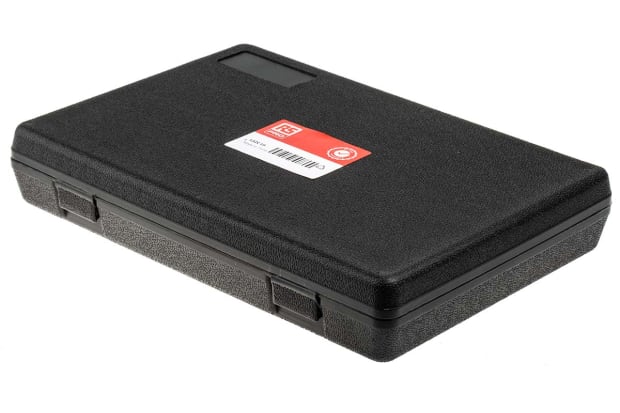
Counterbore or Pilot Drill Bits
Pilot drills, also known as pilot point drills, are precise devices designed to create pilot holes. These are made in construction materials, including wood and plastic, in order to guide the insertion of larger drills or bore-making tools. The pilot hole may be a counterbore - i.e. have a wider section at the top. A set of pilot drill bits will provide a good selection of these important implements.
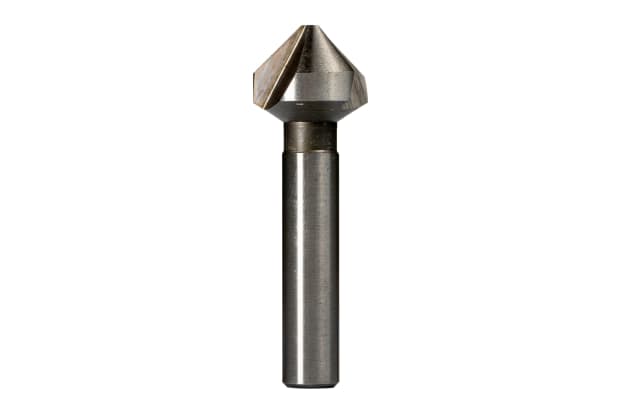
Countersink Drill Bits
A countersink is a conical hole cut into construction material via special drill bits. The primary use of countersinks is to provide a home for countersink bolts or screws, which can have aesthetic or safety benefits. A precise fit is needed for these. Countersink drill bit sets provide a good selection of these tools.
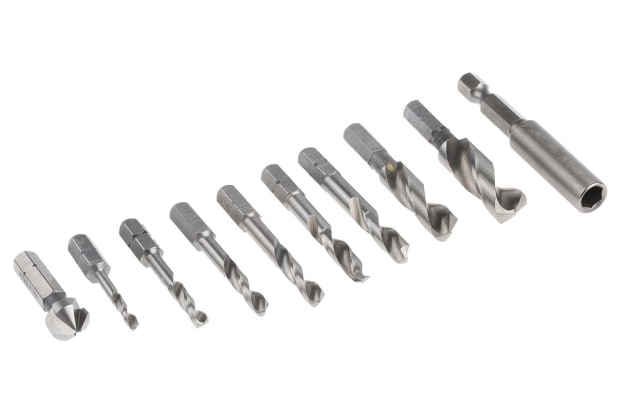
Hex Drill Bit Sets
Hex bits feature hexagonal shanks, either machined onto a round shaft or arising from an originally hexagonal bar. Hex drill bit sets feature a selection of the most useful bits for professionals and DIY enthusiasts alike.

Jobber Drill Bits
Jobber drill bits are long and thin; the length is typically 9-14 times the diameter. They are one of the most widely used types of drill bit, suitable for a variety of less demanding jobs. Some jobber drill bit sets are impressively large, offering a comprehensive selection of lengths and sizes.
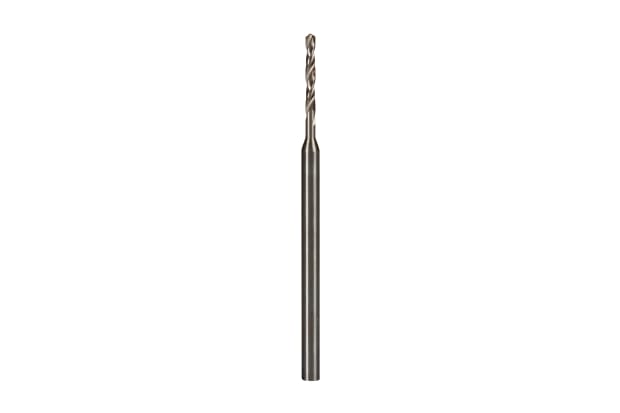
Micro Drill Bits
These are smaller bits designed for precise, close-up work. They can be used with such materials as steel, aluminium, brass, polycarbonate and glass fibre. Micro drill bit sets typically range from just 0.5mm to 2mm.
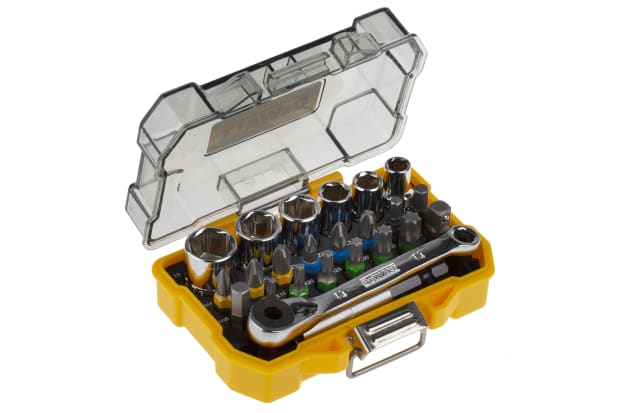
Screwdriver and Drill Bit Sets
Drill bit and screwdriver accessory sets combine drilling attachments with screwdriver bits. The latter are detachable heads primarily made from steel in a variety of standard screwdriver designs (Phillips, Slotted, Pozidriv, Torx, etc). These can be attached via a shaft or chuck to manual screwdrivers or drill drivers - a power tool which combines drilling and screwing functions.
Drill Bit Sets for Drilling Different Materials
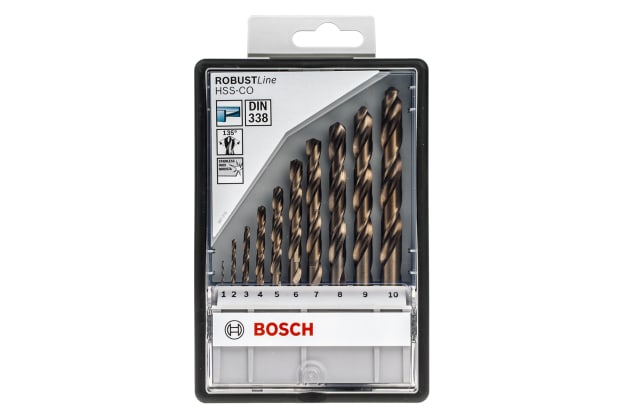
Drill Bit Sets for Metal
Drill bit sets for working with metal typically contain a selection of tough steel and cobalt alloy bits in a vigorous, tapered design for a high level of cutting power without compromising precision or safety. Metal drilling produces a lot of friction so various heat-resistant chemical coatings are also applied by default.

Masonry Drill Bit Sets
Masonry drill bits are typically long and thick with a threaded shaft, made to cut cleanly through tough materials like concrete and stone. Masonry drill bit sets provide a good selection for builders and masons.
Wood Drill Bit Sets
These drill bit sets are aimed at carpenters or other professionals who regularly work with timber. They contain a selection of driver bits specially designed to grind and bore through wood neatly and cleanly, with a minimum of burr. When working with wood, the emphasis lies in precision and smooth operation.
Drill Bit Sizes
Drill bit sets include a collection of drill bits, typically featuring a range of sizes to ensure suitability for different applications. Drill bits are the tools which allow drills to cut holes into different materials through the application of circular torque, or rotational force. The upper part of a drill bit is called the shank and this is attached to the chuck, a special clamp within the main body of the drill.
Most modern drill bits are made from various types of steel. Some of the most common types include:
- Carbon Steel – this is the ideal choice if you need a tough drill bit able to cut into harder substances. Carbon steel is resistant to high temperatures and bits made from this material typically have longer lifespans than alternative options
- High-Speed Steel (HSS) – this material remains firm when subjected to high temperatures and can cut quickly and accurately
- Cobalt Steel – the cobalt admixture increases strength and resistance to both heat and friction
- Tool Steel with Tungsten Carbide Tips (TCT) - these have a tough and stable tip with a longer working life
In addition to the use of alloys, modern drill bits often include chemical coatings to enhance their performance. Common coatings include:
- Black Oxide – this prevents corrosion and increases resistance to stress. It also helps to retain any lubricants which have been applied, making it a good choice for iron and steel drilling
- Bronze Oxide – this coating is also an effective choice for additional stress resistance. It is often used to help identify cobalt steel and can be used in combination with black oxide to help identify high-speed steel bits
- Titanium Nitrate – added to increase the rigour of drill bits, this coating also helps to protect against the high temperatures generated by frictive materials like iron, steel and aluminium, thereby increasing their lifespan
- Ferrous Oxide - another coating which provides effective shielding against heat
Drill bit sets are useful because they contain a selection of drill bits in different shapes and sizes. Some contain bits specifically designed for use with certain substances - for example, masonry, wood, metal, plastic, concrete etc - while others are intended to meet the needs of professionals who routinely work with multiple materials.
Drill bit sets made specifically for hobbyists and DIY enthusiasts are also available. These tend to feature smaller bits intended for lighter work. Drill bit sets are normally supplied in sturdy carry cases, with individual components on clear display for ease of use.
FAQs
Can I Use a Concrete Drill Bit on Wood?
Yes, a masonry drill bit will cut through wood, but as the bit is not specifically designed for this material you are likely to end up with a rough, imprecise hole. Conversely, a dedicated wood drill shaves through wood in a similar way to a chisel.
How Do You Put a Small Drill Bit in a Drill?
Smaller drill bits - for example, 1/8th of an inch - can be difficult to insert into the chuck (clamp) of many drills. If not properly secured, they can slip during use. It is always best to consult the manual as in some cases, insertion by hand rather than the motor may be an appropriate choice. When in use, do not press down too hard and let the drill do the hard work of cutting.
What is the Strongest Drill Bit?
The strongest drill bit material is carbide. It is used only in demanding, professional settings in combination with high-end tool holders and equipment in order to cut the hardest materials. It is brittle and unsuitable for use in hand drills and drill presses.
How Do You Choose the Right Drill Bit for Your Job?
The most common drill bit types include:
- Twist Drill Bits – these feature helical grooves and they are the most widely used type of drill bit. Twist drill bits are adaptable - ideal for use with wood, plastic, and metal, and equally suited for both professional and hobbyist applications
- Masonry Drill Bits – these are generally made from TCT and are designed for use with bricks, blocks, stone, mortar, and related construction work material. It is common to combine them with a hammer power tool
- Slotted Drive System (SDS) Drill Bits – these are specifically designed for use with power tools. The SDS system is ideal for use with harder materials like concrete
How Do You Change Drill Heads?
The precise procedure for changing drill heads varies from model to model but the fundamental steps are as follows:
- Select the right drill bit for the material you plan to cut, taking its size and depth into account
- Open the chuck - the mechanical clamp which holds the drill bit in place on your device. There will a switch, handle or grip for this purpose
- Remove the old bit from the chuck and insert the replacement, ensuring it clicks firmly into place before reclosing the chuck
What is the Best Drill Bit Set?
The best drill bit set will depend on the type of work you are undertaking. If you primarily work with wood or timber, for example, you should look for bits specifically designed for use with this material. Other designs may succeed in boring a hole but they may require extra effort and they will not do as good a job.
Do All Drill Bits Fit?
Modern drills are fairly flexible and most will work with drills bits of different lengths as long as the shank of the bit will fit within the chuck. In general, branded drill bits will also work in drills from other manufacturers as long as the overall size is compatible. Standard sizes are used by all drill and bit manufacturers.
However, it is also worth bearing in mind that some drill designs may not be suitable for certain tasks, regardless of which bits have been fitted. For example, a timber drill may not deliver sufficient cutting power for jobs involving metal. Similarly, some types of drill bit are unsuitable for certain applications, regardless of whether they fit into the chuck of a particular drill.
What are the Best Drill Bits for Steel or Stainless Steel?
HSS will get the job done when boring into softer steel but for stainless steel and other harder variants you will need HsCO. This is high-speed steel with a 5-8 per cent cobalt admixture for extra toughness. Carbide is even stronger but this requires special equipment and should only be used in the most demanding professional settings.
Popular Brands
Click on the buttons below to view drill bit sets from some of our bestselling brands.
Related links
- A Complete Guide to Crimp Tools
- Oscilloscopes - A Complete Guide
- Microscopes – A Complete Guide
- Sharpening Stones - A Complete Guide
- Inspection Cameras - A Complete Guide
- Drill Bit Sets
- RS PRO 25-Piece Twist Drill Bit Set for Metal 1mm Min, HSS Bits
- RS PRO 170-Piece Twist Drill Bit Set for Metal 1mm Min, HSS Titanium Coated Bits





